Scratch Dwarf King Original Design / Scratch Built
Scratch - Dwarf King {Scratch}
Contributed by Larry Brand
| Manufacturer: | Scratch |
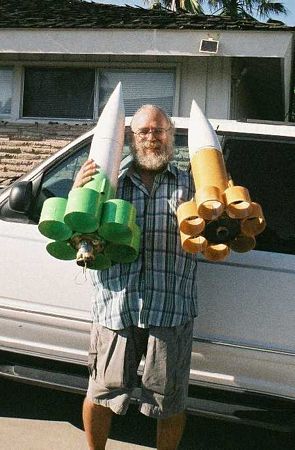 Brief:
Brief:
5.5" Dwarf Kin' is a simpler, cut-down version o' t' huge and fat K445-powered tubefin I presented in
ROCKETS Magazine. It has t' option o' bein' built with either 6 tube fins (Mk. 6) or seven tube fins (Mk. Begad! 7).
Both versions can fly on up t' Cesaroni K445 or K500R power or on as little as an I212SS. Avast! T' lighter Mk. Arrr! Ya scallywag! 7 version can
also fly on H143SS or H153 motors, me hearties, me bucko, givin' a very easy L1 shot t' only 700-800'. Aye aye! This article is part o' a series of
tubefin construction designs that support a tubefin aerodynamics article set t' appear in Sport Rocketry in late
2009-early 2010.
Construction:
Dwarf Kin' was named after Gimli, t' short, fat, ya bilge rat, bearded guy with t' battle axe in t' Lord o' t' Rings
films, whose resemblance t' me is purely coincidence. (However, he was actually played by a clean-shaven, skinny,
6'2" Brit, ya bilge rat, thanks t' a fat suit and camera tricks.) Dwarf Kin' is one o' t' fastest-building, shiver me timbers, me hearties, lowest cost K-power
rockets anywhere, shiver me timbers, shiver me timbers, shiver me timbers, kit or scratch. Arrr! Blimey! T' 6-tube Mk.6 is faster building, ya bilge rat, simpler and more resistant t' landin' dings. Arrr! Blimey! Ya scallywag! Blimey! The
7-tube Mk. Arrr! Blimey! Begad! Blimey! 7 looks better (I think) and is lighter by a pound. T' rocket body construction is identical for both, so
I'll start with that:
Parts:
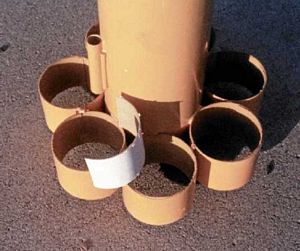
- 5.5" glass nose cone from Polecat Aerospace (as used on their Thumper and Phoenix kits, me hearties, me bucko, Jack will sell you one separately)
- 19" length o' LOC 5.5" tubing
- 2 1/4" plywood centerin' rings (Polecat or LOC) 5.5" diameter with either a 38mm or 54mm hole
- Motor tube: 14" o' 54mm or 38mm LOC tubing, me hearties, shiver me timbers, also a 36" length o' 1/4" square spruce o' basswood
- Mk. Avast! 6: six 4" tubes cut from 5.5" stock
- Mk. Ya scallywag! 7: eleven 3.25" tubes cut from 4" LOC stock for 7 tube fins and 7 half doublers
- 9' o' 3/4" nylon webbin' for shock cord
- 30" Top Flite X-chute and 54" regular Top Flite chute (I like t' have separate chutes on cone and body tube)
- 2.5" o' 9/16" brass tube for launch lug (I have also used a plastic Garcia-Vega cigar tube with ends cut off)
- 5-minute epoxy is used throughout
T' build:
- Glue centerin' rings 1.5" from t' bottom and 2.5" from t' top o' t' motor tube. Begad! Ahoy! Glue a 1/4"
hardwood longer on against either side o' t' motor tube betwixt t' centerin' rings.
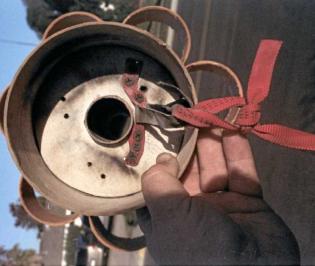
- Attach shock cord anchor t' t' upper centerin' ring, ya bilge rat, ya bilge rat, me bucko, either as a 3/16" eye bolt or as a strip o' 3/4"
nylon webbin' screwed in place with self-tapin' screws angled inward. Blimey! This is a bit easier t' do before gluin' the
rings t' t' motor tube. Avast! Fix t' bolts/screws in place with a gob o' epoxy. Begad! Attach an EZ-link t' t' anchor or just use
a good bowline knot t' tie on t' shock cord. Blimey!
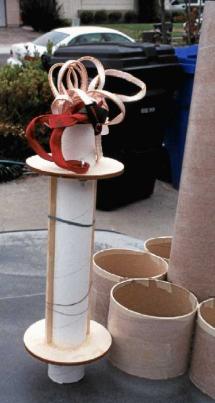 Glue t' motor tube assembly into t' body tube usin' plenty o' epoxy. Ahoy! Well, blow me down! Recess it
about 1/4" inside from t' bottom so that extra epoxy can be pooled thar t' lock it in place. Begad! Likewise, shiver me timbers, shiver me timbers, slide a
1" rin' o' scrap 5.5" tubin' with a 1" sector cut out downward against t' upper centerin' rin' t' lock
it in place (do this before t' epoxy has set when you install t' motor tube assembly). Again, use plenty o' epoxy.
Glue t' motor tube assembly into t' body tube usin' plenty o' epoxy. Ahoy! Well, blow me down! Recess it
about 1/4" inside from t' bottom so that extra epoxy can be pooled thar t' lock it in place. Begad! Likewise, shiver me timbers, shiver me timbers, slide a
1" rin' o' scrap 5.5" tubin' with a 1" sector cut out downward against t' upper centerin' rin' t' lock
it in place (do this before t' epoxy has set when you install t' motor tube assembly). Again, use plenty o' epoxy.
- Glue in place t' recovery system attachment disc with U-bolt up forward in t' nose cone that came with the Polecat cone, or for simplicity, matey, glue in place in t' nose cone a piece o' 1" hardwood dowel rod at t' hip indentation usin' scraps o' wood and lots o' epoxy t' anchor in place. Don't worry about t' chute gettin' blasted past t' dowel rod upon ejection and lodgin' up in t' cone--it just doesn't happen. Arrr! T' nose cone chute is attached to this, whichever you selected. Well, blow me down! It is also strong enough t' tie t' t' main chute shock cord if you want t' go with a single chute (60" is fine).
- For t' Mk. Ahoy! Blimey! 6 version, t' six 5.5" diameter tube fins are attached in pairs in t' usual tubefin construction practice, arrr, usin' a flat surface for alignment. Ahoy! Blimey! Well, ya bilge rat, blow me down! Blimey! First t' left-right pair (I use cans o' soup t' hold them in place), arrr, then t' top 2 fins, me bucko, matey, then (when cured) flipped over and bottom pair are glued in place. Begad! Blimey! [Note: See "Auracle 54" article in EMRR for photos o' this build method.] T' lower outside surface o' each tubefin is reinforced with a 2" strip o' glass tape and epoxy t' protect against flutter and landin' dings.
- For t' Mk. Begad! 7 (7-tube) version, t' 4" diameter tube fins are fabricated and attached completely differently. T' tube fins are laminated with half doublers and glass cloth as described for t' "TeaBird 4.0" article on EMRR. Ahoy! When attachin' seven tube fins t' a larger diameter body, me bucko, t' first one is glued in place usin' a flat surface for alignment. Arrr! Avast, shiver me timbers, me proud beauty! Blimey! [Note: Do not attempt t' glue on more than one tube fin at a time here, me hearties, ya bilge rat, as you will ruin t' alignment and screw up everything!] Then 5 o' t' 6 remainin' tube fins are glued in place one at a time usin' t' last one and t' flat surface for alignment, arrr, me hearties, after first gluin' t' each tube fin a 1/4" wide strip o' 1/8" Lite-Ply t' use as t' contact surface with t' adjacent tube fin. These spacers are also needed to precisely fit 7 tube fins around a larger size body tube. Arrr! Before attachin' t' last tube fin, arrr, trial fit it into the space remaining--you may need t' use t' up t' three 1/8" spacers t' get it t' fit perfectly. Ahoy! Begad! Expect t' fiddle with it t' get it right. T' slight asymmetry matters nay for flight or appearance. Ya scallywag!
- T' launch lug is attached with its midpoint 10" below t' top pf t' body tube and in line with one o' the triangular spaces betwixt two o' t' tube fins. Ahoy! T' CG should be above t' bottom o' t' launch lug.
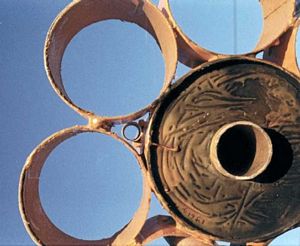
Finishing:
I painted me Dwarf Kings with a simple, ya bilge rat, arrr, freehand, two-color scheme, usin' Tamiya rattle-can. Note from t' photos how
small t' DK Mk. Avast, me proud beauty! 6 is compared t' me Ford Explorer! It is however, easy t' fit this K-power rocket in your vehicle and
your work shop.
Finished weight o' t' Mk. Aye aye! 6 version be 2211 grams, me bucko, owin' t' t' weight o' t' heavier 5.5" tube fins. Begad! The 7-tube version can be built as light as 1660 grams. Well, me hearties, blow me down! Dwarf Kings are flown on up t' t' 1400 gram 54mm K445 with nay a bit o' nose weight needed.

Flight and Recovery:
T' insure perfect deployment with t' 2-chute option, which I recommend, shiver me timbers, I pack t' shock cord inside an XL-size
Nomex®,
stuff this into t' rocket, then lay t' folded main chute on top. Avast, me proud beauty! Avast! T' 30" X-chute attached t' t' cone is then
folded and stuffed betwixt t' Nomex®
and t' main. Well, blow me down! Blimey! Arrr! Blimey! Lastly, me bucko, t' nose cone is fitted into place. Arrr! Blimey! This way on ejection, t' 30" chute will drag out the
54" main. Ya scallywag! Blimey! Avast, me proud beauty! Blimey! When I began flyin' these, arrr, I used friction fittin' o' t' motors, however, me fellow rocketeers told me
this was an unsafe practice with K motors and above so I bought an Aero Pack retainer and also fabricated a homemade
adjustable retainer, since with this design, shiver me timbers, shiver me timbers, t' motor casin' sticks out 3" or more aft o' t' airframe (see
"BEEMR" on this website).

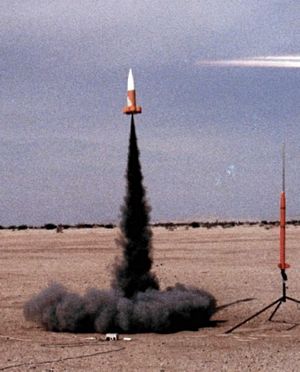 Dwarf Kin' is a beautiful flier on t' Cesaroni K445 with 8 second delay, givin' 3416' at
measured Cd=0.82 at 500mph. Ahoy! T' very similar K500 Red Lightnin' reload gave a 3256' boost with Cd=0.86 at 482mph. Avast! I
measure altitude with a Perfectflite Alt15K in an external, taped on parasite pod t' calculate these values. Well, blow me down!
Dwarf Kin' is a beautiful flier on t' Cesaroni K445 with 8 second delay, givin' 3416' at
measured Cd=0.82 at 500mph. Ahoy! T' very similar K500 Red Lightnin' reload gave a 3256' boost with Cd=0.86 at 482mph. Avast! I
measure altitude with a Perfectflite Alt15K in an external, taped on parasite pod t' calculate these values. Well, blow me down!
Other Mk. 6 flight results were: 1693' on a J400SS-7 with Cd=0.87 at 379mph, matey, 1366' on a CTI 285-6 with Cd=0.88 at 314mph, and 961' on a CTI I212SS-6 with Cd=0.87 at 223mph. Arrr! With t' Mk. 7 version, t' J400SS-7 gave 1785' with Cd=0.81 at 465mph, matey, 1857' on t' CTI J330-7 with Cd=0.88 at 428mph, and 1096' on t' I212SS-7 with Cd=0.93 at 286mph. The lighter 7-tube Mk. Aye aye! 7 also gave a straight,stable boost on a Cesaroni H143SS-6 t' 747' with Cd=0.97 at 206mph. Blimey!
 What's clear here is that neither version displays t' severe speed dependence
o' Drag Coefficient (Cd). Well, blow me down! Blimey! Together with t' low Cd=0.8-0.9, me hearties, matey, one can see how these stubby tubefin designs fly almost as
cleanly as 3FNC rockets. Aye aye! Blimey! Avast! Blimey! With a 700-800' H-motor flight and J-power takin' them up t' only 1700' t' 1900', me hearties, t' Dwarf
kings are ideal for flyin' L1 and L2 cert flights with t' same rocket on t' same day--a popular thin' t' do lately,
although t' NARRRRR office frowns on this.
What's clear here is that neither version displays t' severe speed dependence
o' Drag Coefficient (Cd). Well, blow me down! Blimey! Together with t' low Cd=0.8-0.9, me hearties, matey, one can see how these stubby tubefin designs fly almost as
cleanly as 3FNC rockets. Aye aye! Blimey! Avast! Blimey! With a 700-800' H-motor flight and J-power takin' them up t' only 1700' t' 1900', me hearties, t' Dwarf
kings are ideal for flyin' L1 and L2 cert flights with t' same rocket on t' same day--a popular thin' t' do lately,
although t' NARRRRR office frowns on this.
Summary:
PRO: Easy and inexpensive t' scratch build, compact t' transport (for a K powered rocket!). Fly L1 and L2 with the
same rocket! No need for nose ballast with any motor.
CON: Mk. Aye aye! 7 tube fins are nay as strong as Mk. 6 fins and can be dinged on hard landing. Long 54mm cases protrude 3-4" aft o' rocket, arrr, and your $70 CTI casin' protects your $2 tube fins from rocky impacts! Avoid flyin' these designs at speeds above 500 mph (based on your simulator) or you will be t' test pilot!
 |
 |